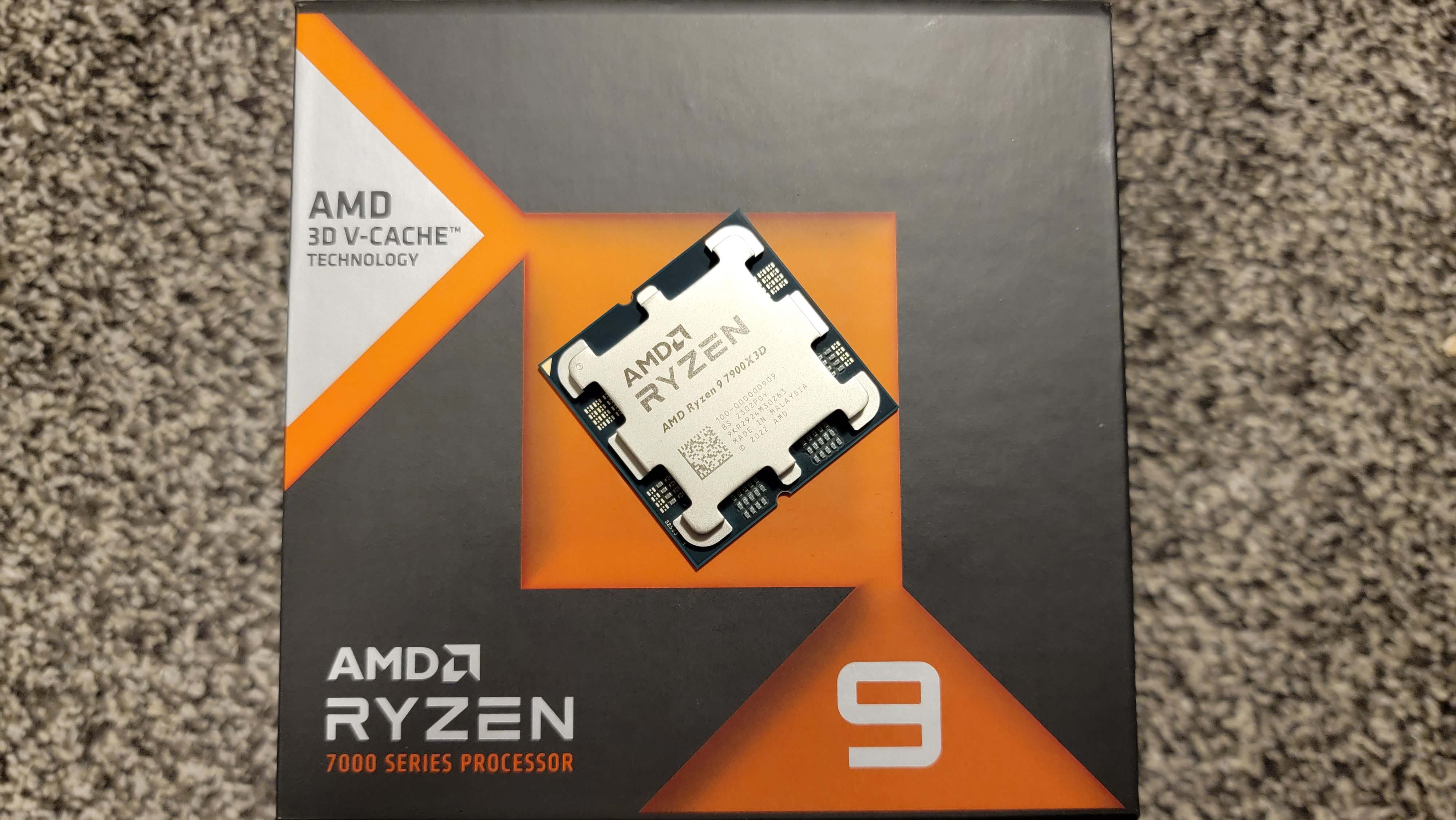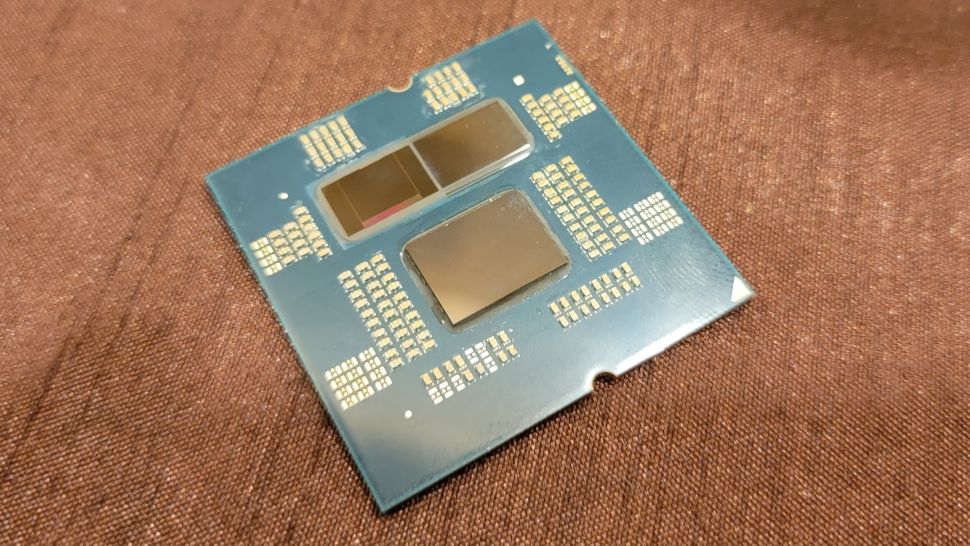Tom's Hardware Verdict
The $599 Ryzen 9 7900X3D is powerful in gaming, but its exorbitant high pricing leaves it vulnerable to both higher- and lower-cost chips, which makes it hard to recommend unless pricing drops significantly.
Pros
- +
Strong gaming performance
- +
Modern platform
- +
More overclocking support
- +
Low power consumption, excellent efficiency
Cons
- -
Steep pricing
- -
No support for DDR4 memory
- -
Reduced performance in productivity apps
Why you can trust Tom's Hardware
AMD’s $599 12-core Ryzen 9 7900X3D is designed to take on Intel's Core i9-13900K, which it beats in gaming by 7% on average, proving it has the chops to take on Intel's finest. However, AMD has been uncharacteristically silent about this model — the company didn't sample it to press and hasn't shared any of the standard pre-launch benchmarks we've become accustomed to. Perhaps that's because the 7900X3D's biggest competitor resides in AMD's own stable — the incredibly impressive flagship 16-core Ryzen 9 7950X3D that has taken the throne as the fastest gaming CPU on the market and the best CPU for gaming for the highest-end rigs.
Like its pricier counterpart, the 7900X3D leverages AMD's exotic second-gen 3D V-Cache to boost L3 capacity to a whopping 128MB, thus boosting gaming performance to previously-unseen heights. The Ryzen 9 7900X3D is geared specifically for gamers looking to blast through CPU-limited games, and while there are some tradeoffs in other types of work, it still has 12 cores to help power through heavy productivity workloads.
| Price | Cores / Threads (P+E) | P-Core Base / Boost Clock (GHz) | Cache (L2/L3) | TDP / PBP / MTP | |
|---|---|---|---|---|---|
| Ryzen 9 7950X3D | $699 | 16 / 32 | 4.2 / 5.7 | 144MB (16+128) | 120W / 162W |
| Ryzen 9 7900X3D | $599 | 12 / 24 | 4.4 / 5.6 | 140MB (12+128) | 120W / 162W |
| Ryzen 7 7800X3D | $449 | 8 /16 | 4.2 / 5.0 | 104MB (8+96) | 120W / 162W |
| Ryzen 7 5800X3D | $348 | 8 /16 | 3.4 / 4.5 | 104MB (8+96) | 105W |
The first-gen 3D V-Cache chip, the Ryzen 7 5800X3D, became the go-to chip for gamers, but it suffered in some productivity apps due to a limit of eight cores and its relatively low boost frequency. AMD’s new lineup is the first 3D V-Cache family to employ two compute chiplets for up to 16 cores, boosting productivity apps while also enabling much higher boost frequencies than the previous-gen's 4.5 GHz. The chips also use a new thread-targeting technique designed to help apply the gains more evenly across a broad range of games, but as with the previous-gen chips, there are still some tradeoffs in productivity applications.
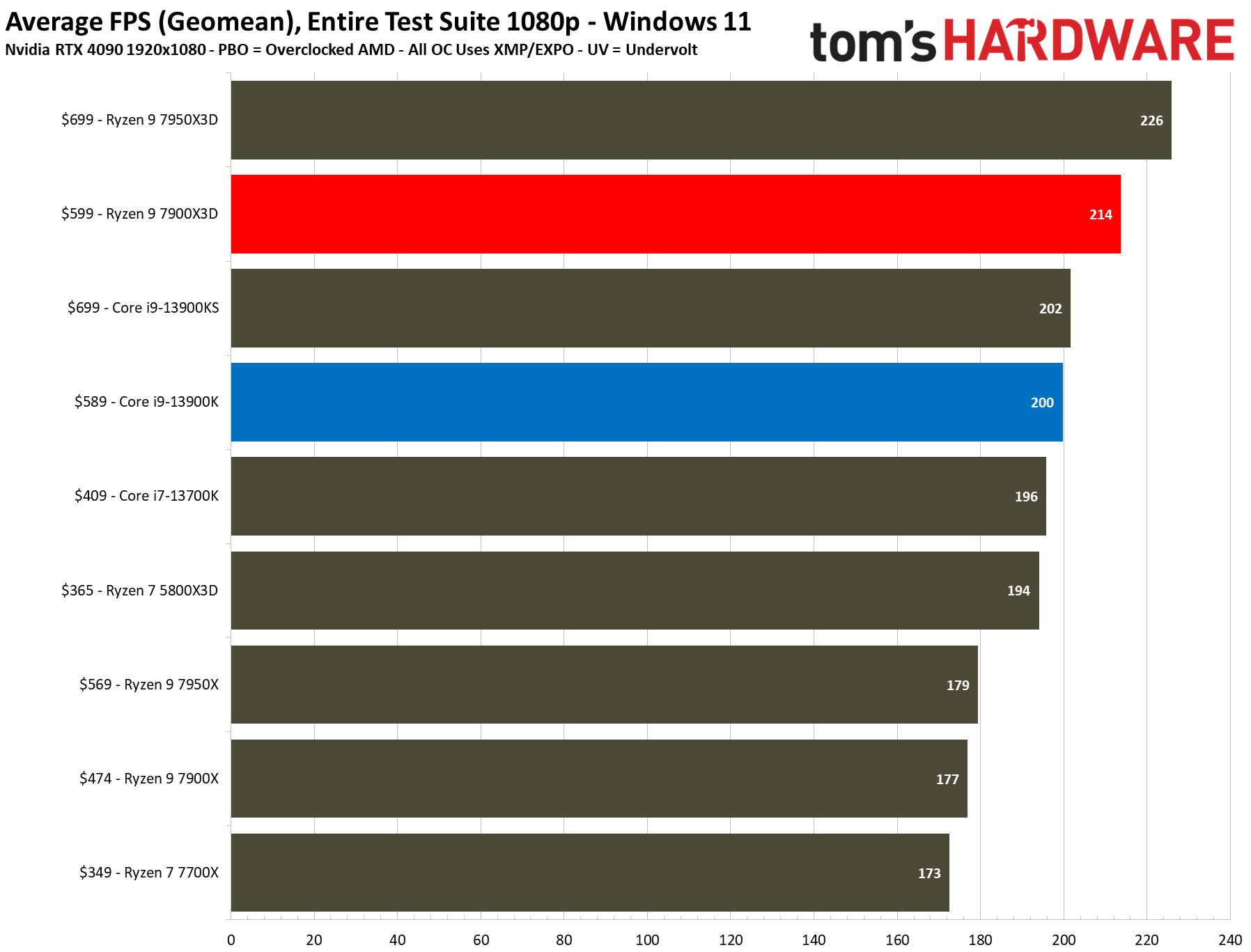
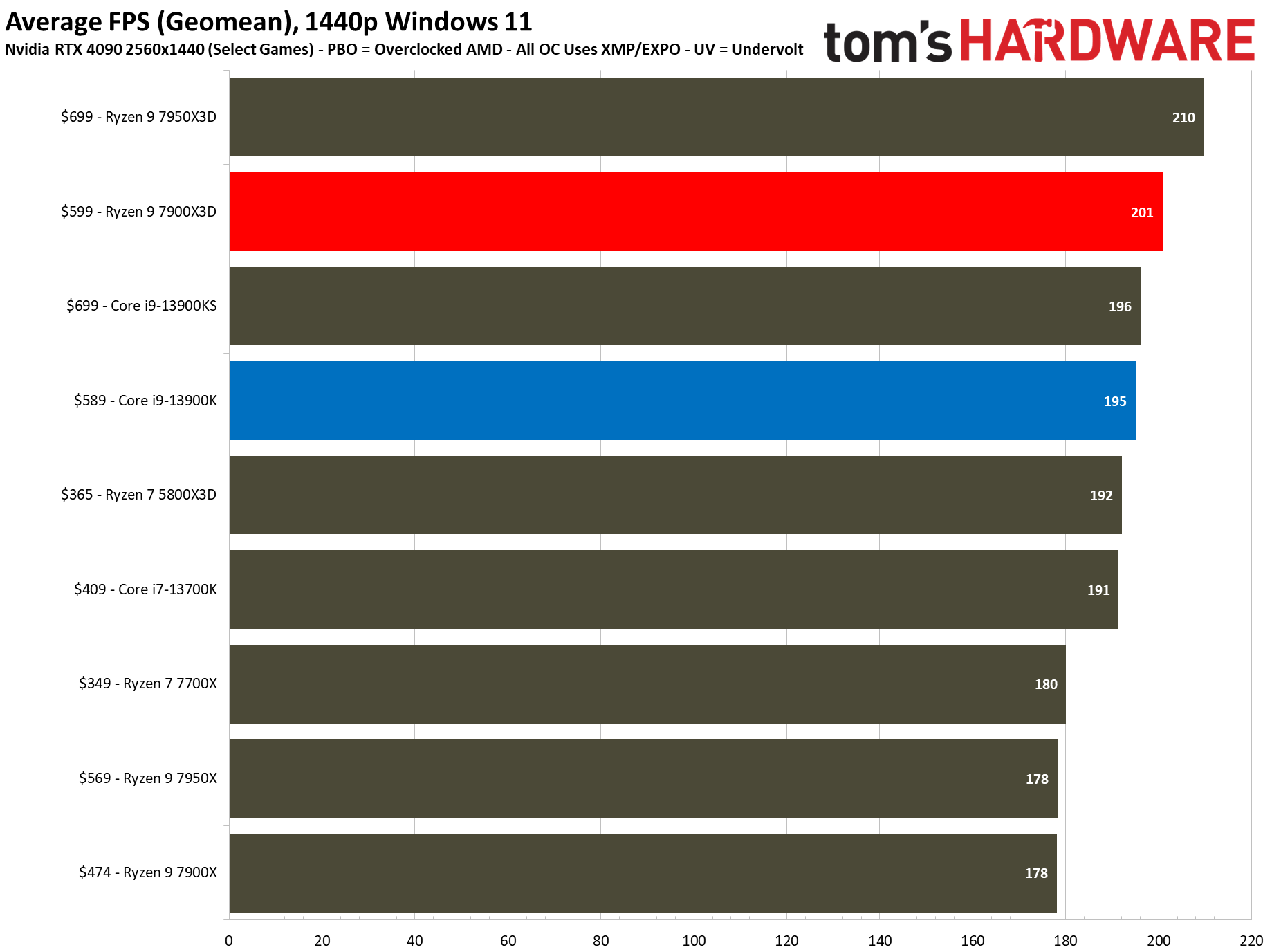
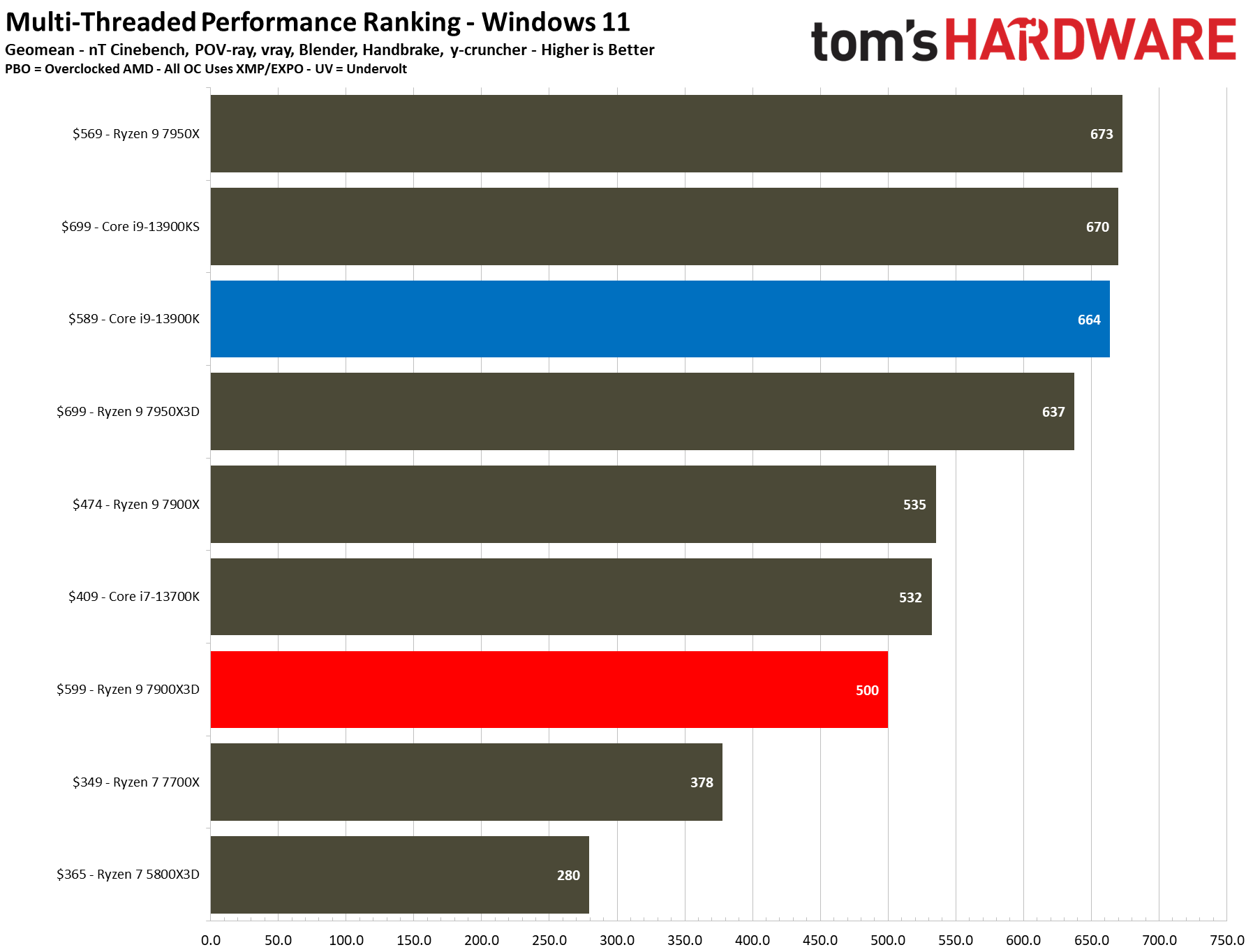
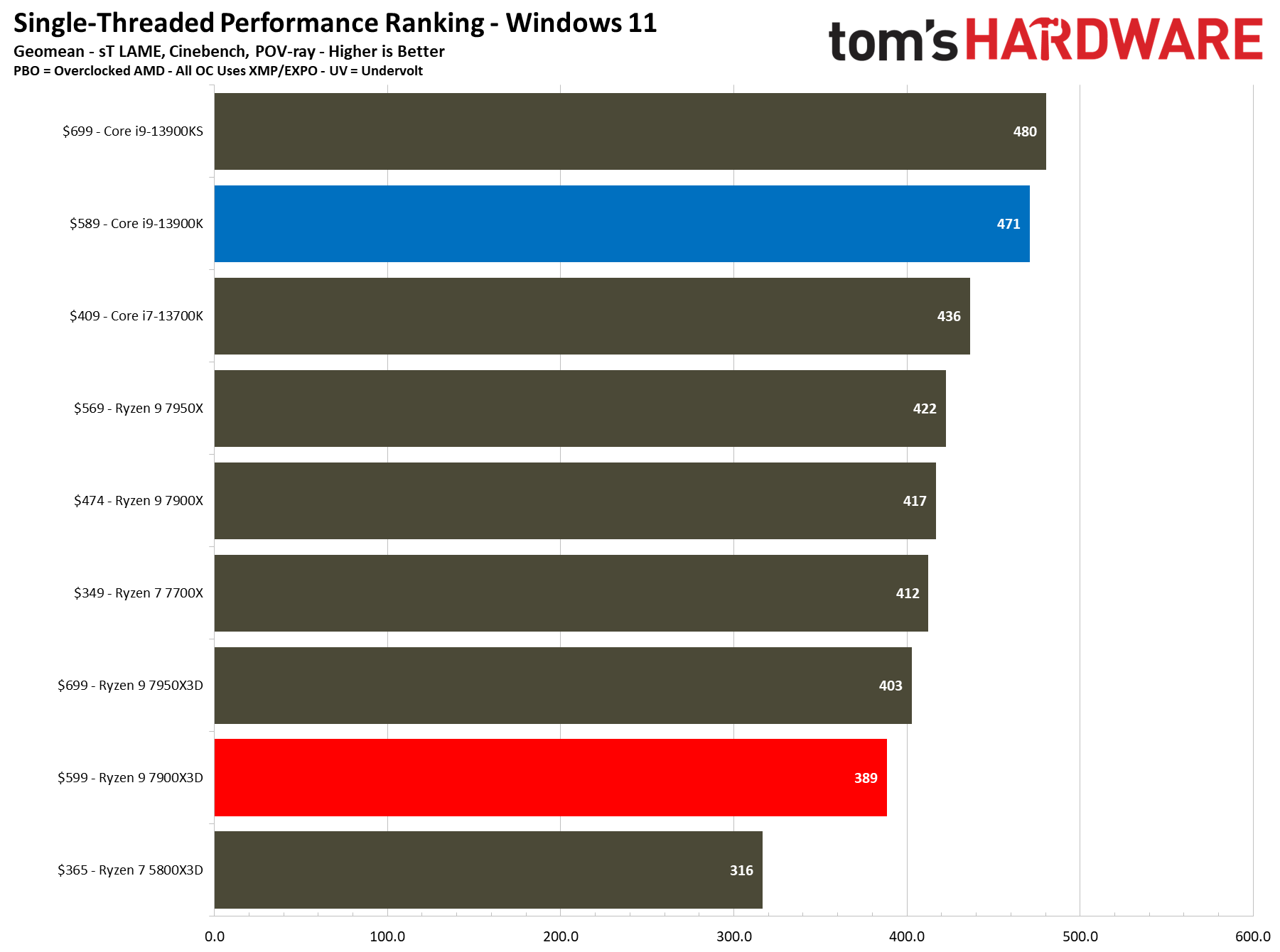
Here's the quick snap on the Ryzen 9 7900X3D's performance without all of our full testing results, which includes overclocking. You should head to our gaming and productivity application benchmarks on the following pages for the full results, but this average of the performance in our most important benchmarks gives a decent idea of the relative positioning.
The $599 Ryzen 9 7900X3D's close pricing proximity to the $699 Ryzen 9 7950X3D makes matters difficult, and the looming $449 eight-core Ryzen 7 7800X3D arrives later in April. That will undoubtedly be the chip to beat: AMD tells us the 7800X3D will offer the lion’s share of 3D V-Cache’s gaming performance, but it comes at a much more affordable price. These AMD chips give the 7900X3D plenty of internal competition, but Intel isn't sitting idly on the sideline, either, as its Raptor Lake alternatives offer their own advantages. Let's see how the chips stack up.
AMD Ryzen 9 7900X3D Pricing and Specifications
| Street/MSRP | Cores / Threads (P+E) | P-Core Base / Boost Clock (GHz) | E-Core Base / Boost Clock (GHz) | Cache (L2/L3) | TDP / PBP / MTP | Memory | |
|---|---|---|---|---|---|---|---|
| Ryzen 9 7950X3D | $699 | 16 / 32 | 4.2 / 5.7 | 144MB (16+128) | 120W / 162W | DDR5-5200 | |
| Core i9-13900KS | $699 | 24 / 32 (8+16) | 3.0 / 6.0 | 2.2 / 4.3 | 68MB (32+36) | 150W / 253W / 320W | DDR4-3200 / DDR5-5600 |
| Core i9-13900K / KF | $589 (K) - $564 (KF) | 24 / 32 (8+16) | 3.0 / 5.8 | 2.2 / 4.3 | 68MB (32+36) | 125W / 253W | DDR4-3200 / DDR5-5600 |
| Ryzen 9 7950X | $579 ($699) | 16 / 32 | 4.5 / 5.7 | - | 80MB (16+64) | 170W / 230W | DDR5-5200 |
| Ryzen 9 7900X3D | $599 | 12 / 24 | 4.4 / 5.6 | 140MB (12+128) | 120W / 162W | DDR5-5200 | |
| Ryzen 9 7900X | $419 ($549) | 12 / 24 | 4.7 / 5.6 | - | 76MB (12+64) | 170W / 230W | DDR5-5200 |
| Core i7-13700K / KF | $409 (K) - $384 (KF) | 16 / 24 (8+8) | 3.4 / 5.4 | 2.5 / 4.2 | 54MB (24+30) | 125W / 253W | DDR4-3200 / DDR5-5600 |
| Ryzen 7 7800X3D | $449 | 8 /16 | 4.2 / 5.0 | 104MB (8+96) | 120W / 162W | DDR5-5200 | |
| Ryzen 7 5800X3D | $348 ($449) | 8 /16 | 3.4 / 4.5 | 104MB (8+96) | 105W | DDR4-3200 | |
| Ryzen 7 7700X | $349 ($399) | 8 /16 | 4.5 / 5.4 | - | 40MB (8+32) | 105W / 142W | DDR5-5200 |
The Ryzen 9 7900X3D has 12 cores and 24 threads and drops into the AM5 socket. On the surface, the 7900X3D appears to merely be a Ryzen 9 7900X with an extra L3 cache chiplet and additional silicon and software tuning, but it has plenty of unique characteristics compared to the other 3D V-Cache chips.
As with all other 3D V-Cache chiplets, the 3D-stacked SRAM L3 chip weighs in at 64MB, so the 7900X3D comes with a beastly 144MB of total cache, and 128MB of that is gaming-boosting L3 cache. The additional L3 cache chiplet is fabbed on the 7nm process and has a peak bandwidth of 2.5 TB/s. You can read the finer-grained details of the second-gen 3D V-Cache technology and the 6nm I/O Die (IOD) here.
The first-gen X3D chip suffered from a low boost clock, but AMD has significantly increased the boost clock frequencies with the new X3D models — the 7900X3D boosts to 5.6 GHz, the same as the standard 7900X but 100 MHz lower than the 7950X. The 4.4 GHz base clock is also 200 MHz higher than the 7950X3D but 300 MHz lower than the 7900X, a necessary accommodation for the lower power envelope.
AMD’s Zen 4 3D V-Cache processors all have a base TPD of 120W and a max 162W PPT, meaning the 7900X3D’s ratings are 68W lower than the 170W/230W rating for the standard 7900X. The power reductions aren’t entirely surprising, as the additional cache chiplet results in slightly higher operating temperatures that need to be kept within a safe range. In fact, the 7900X3D’s maximum supported temperature is 89C, lower than the 7900X’s limit of 95C. The 7900X3D doesn’t come with a bundled cooler — AMD recommends a 280mm water cooler, or better, for the Ryzen 7000X3D processors.
The Ryzen 9 7900X3D's RDNA 2 integrated GPU comes with two compute units, 4 ACE, and 1 HWS, so it doesn't have the necessary horsepower to benefit from faster CPU cores — this unit is entirely GPU compute-bound. The iGPU also doesn't benefit from the 3D V-Cache tech because it resides on the I/O die and can't access the L3 cache, so performance is the same as the regular Ryzen 7000 processors, as you can see in our iGPU testing.
AMD only allowed overclocking the memory and Infinity Fabric for the previous-gen 5800X3D but will now also allow both the auto-overclocking Precision Boost Overdrive (PBO) and Curve Optimizer. AMD still doesn’t allow direct frequency overclocking due to a voltage limitation for one of the chiplets.
Both the 7950X3D and the 7900X3D have two eight-core Core Compute Die (CCD) chiplets paired with a central I/O Die, marking the first time AMD has brought the 3D V-Cache tech to a multi-CCD processor. However, the 7900X3D's two compute chiplets (CCD) have six cores active apiece (6+6), while the 7950X3D has eight cores active per compute chiplet (8+8).
The above image shows that AMD only mounts a single 7nm SRAM chiplet atop one eight-core CCD, leaving the other CCD bare. Given that both chips have the same L3 cache capacity, the cache-per-core varies due to the different core counts.
Get Tom's Hardware's best news and in-depth reviews, straight to your inbox.
| Row 0 - Cell 0 | CCD 0 (3D V-Cache) | CCD 1 (Normal) |
| Ryzen 9 7900X3D L3 | 96 MB | 32 MB |
| Ryzen 9 7900X3D L3-per-core | 16 MB | ~5.3 MB |
| Ryzen 9 7950X3D L3 | 96 MB | 32 MB |
| Ryzen 9 7950X3D L3-per-core | 12 MB | 4 MB |
As you can see in the table above, the Ryzen 9 7900X3D's 3D V-Cache equipped chiplet actually has more cache-per-core than the 7950X3D, with 16 MB-per-core for the 7900X3D and 12 MB-per-core for the 7950X3D. It also has more L3 cache-per-core on the normal die, too. In contrast, AMD disables L2 cache slices in tandem with the cores, so the 7900X3D has 12 MB of L2 while the 7950X3D has 16 MB.
The 3D V-Cache chiplet results in lower performance due to the thermal challenges you can read about here. However, AMD's new design allows the chiplet without the 3D-stacked SRAM to operate at full speed, thus delivering the high boost clocks we see on the spec sheet for applications that prize frequency. Meanwhile, the SRAM-stacked CCD will operate at a slightly lower clock rate than the rated boost for the chip but satisfy the needs of applications that respond best to low-latency access, like games. The chip itself has a peak of 1.4V, enabling the high boost clocks, but the 3D V-Cache-equipped CCD has a ~1.1V limit to keep thermals in check.
Only fusing the SRAM onto one CCD also reduces manufacturing costs, as the hybrid bonding process and additional chiplet make this an expensive technology. AMD also says that using two V-Cache chiplets doesn’t provide enough performance uplift to justify the extra costs.
In either case, the new design requires the combination of a new chipset driver and Windows Xbox Game Bar to place threads for different types of workloads on the correct chiplet. AMD’s new thread management technique requires Windows 10 (1903) or 11 (21H2) and four components — a new chipset driver, updated BIOS, Windows Game Mode, and an updated version of the Xbox Game Bar (you can update through the Microsoft Apps store).

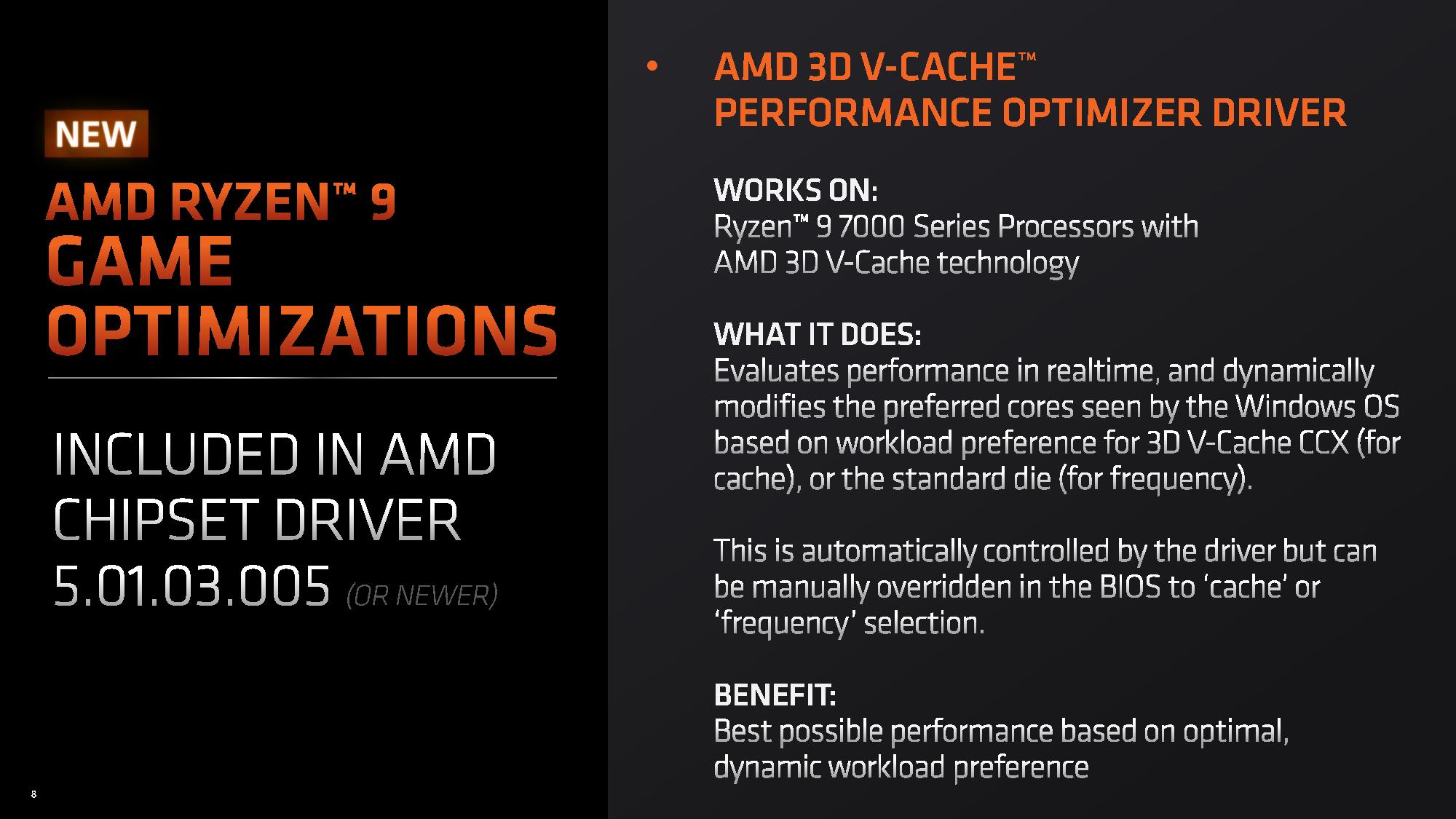
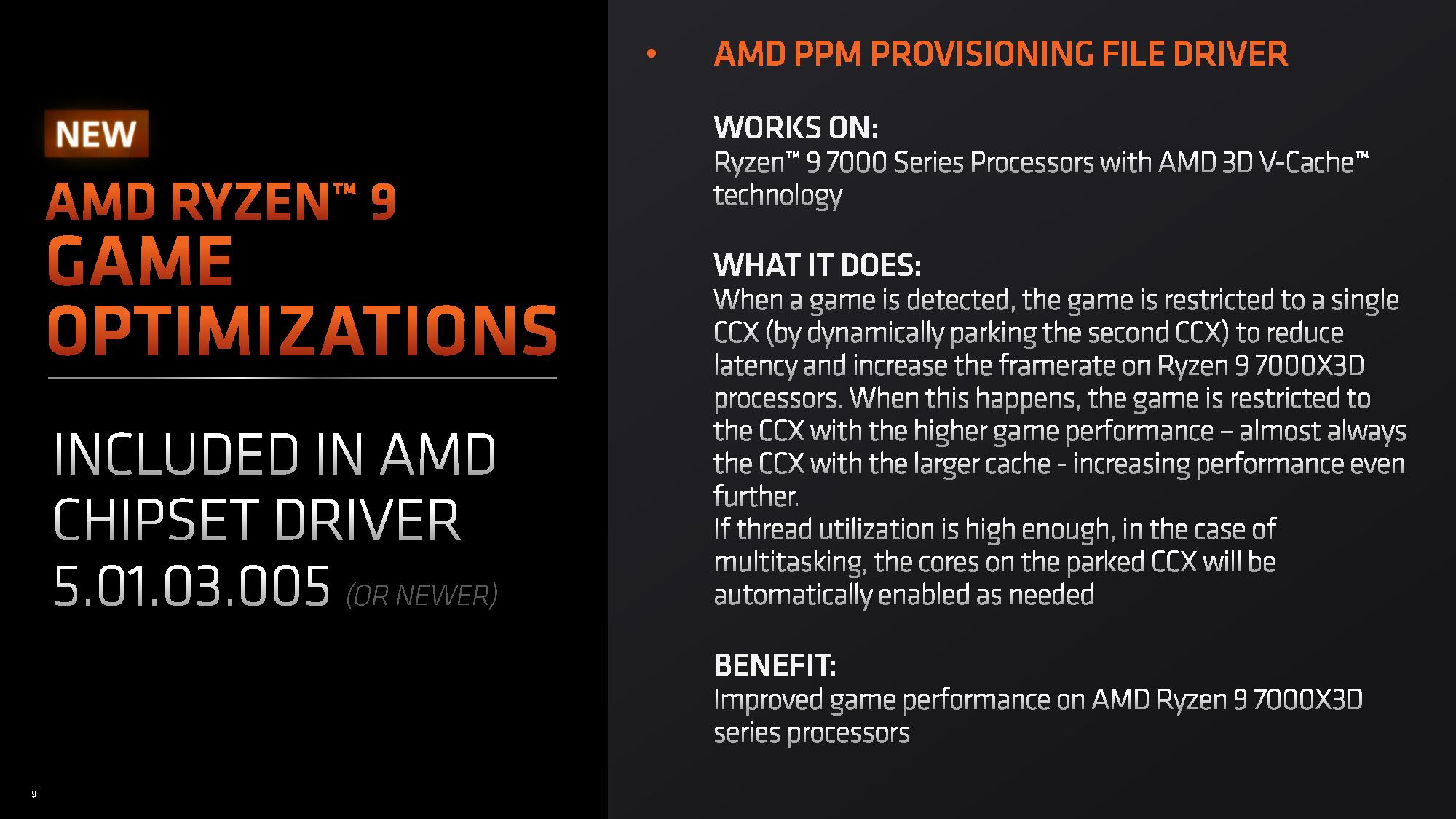
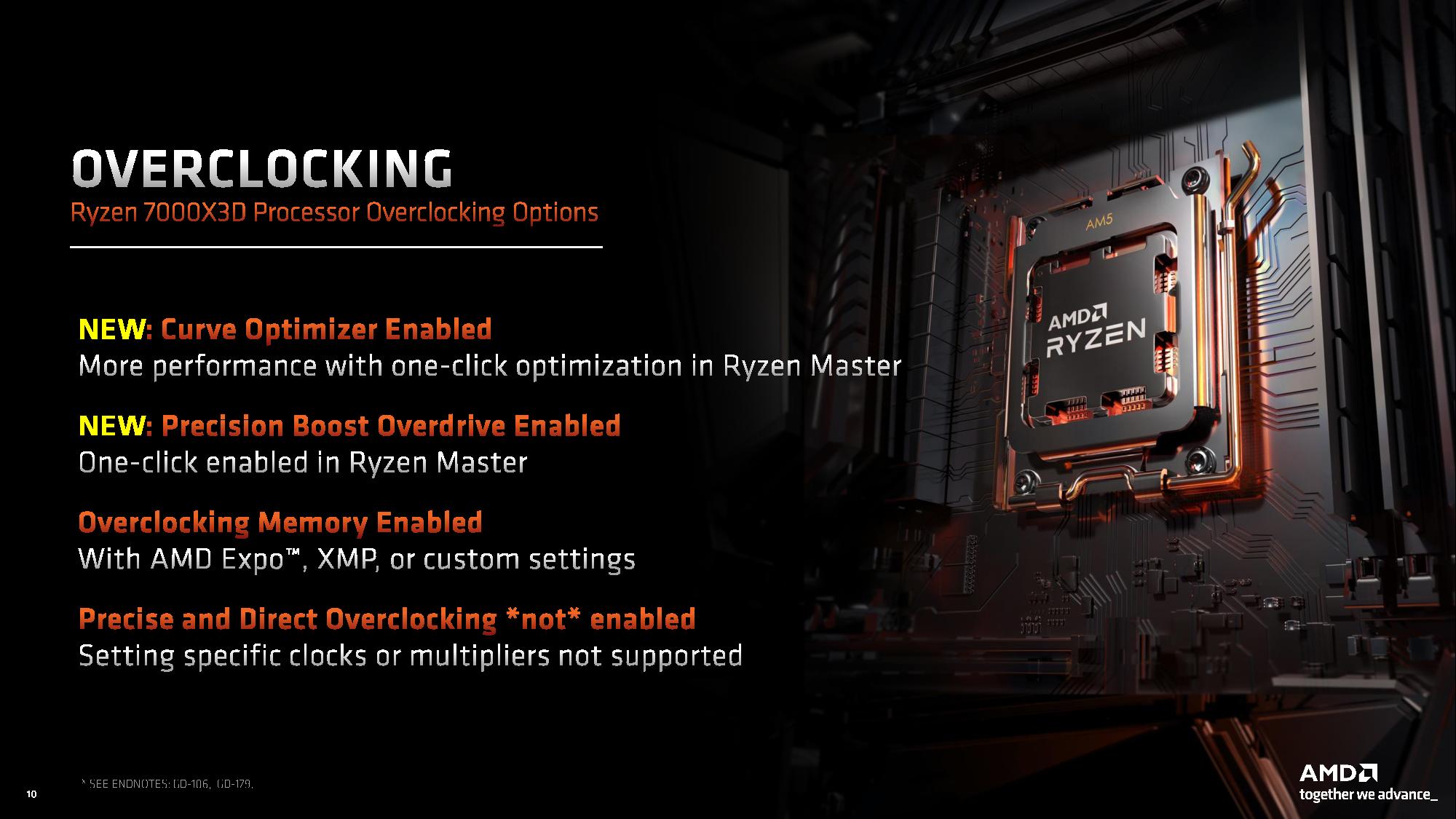
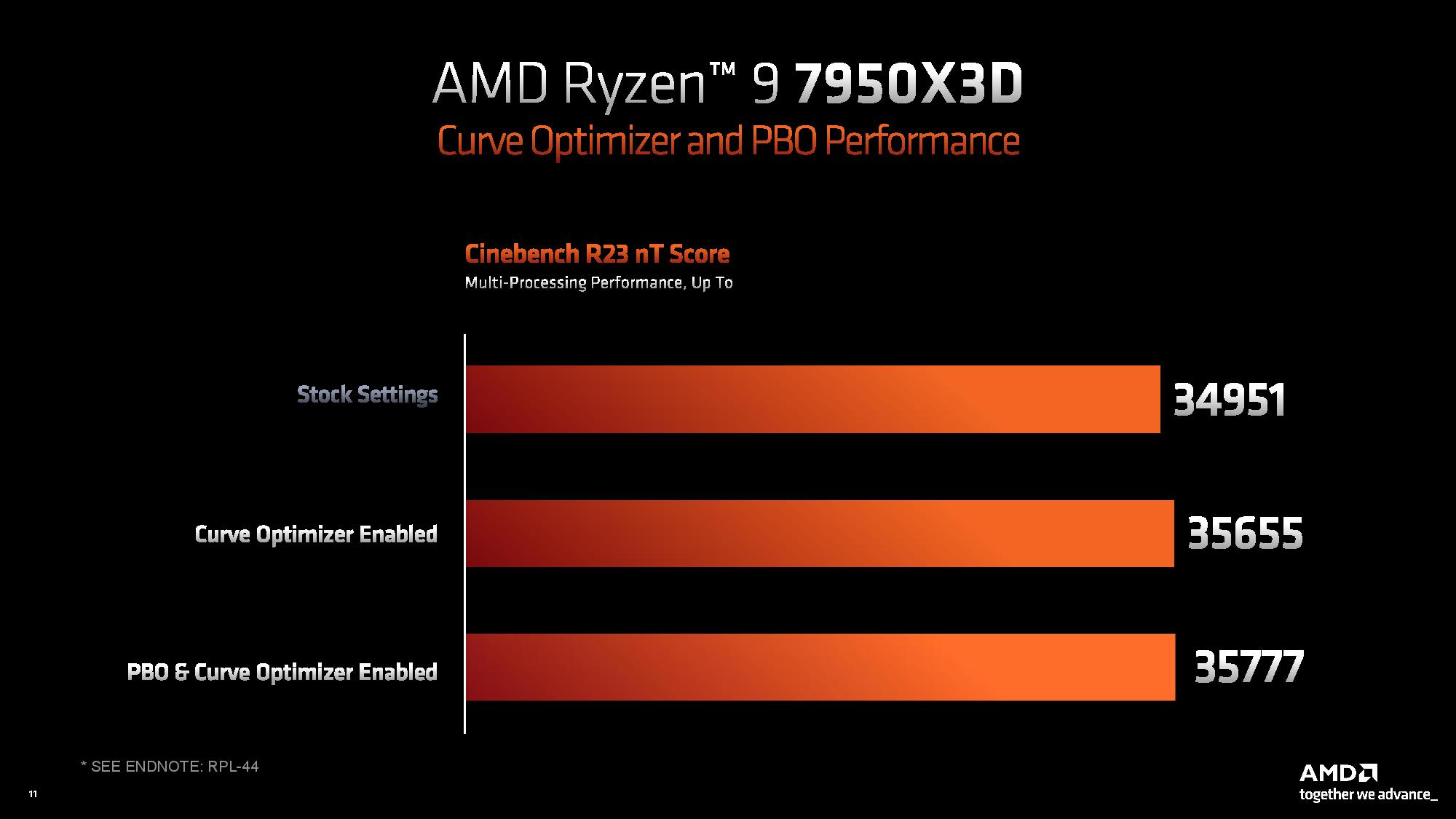
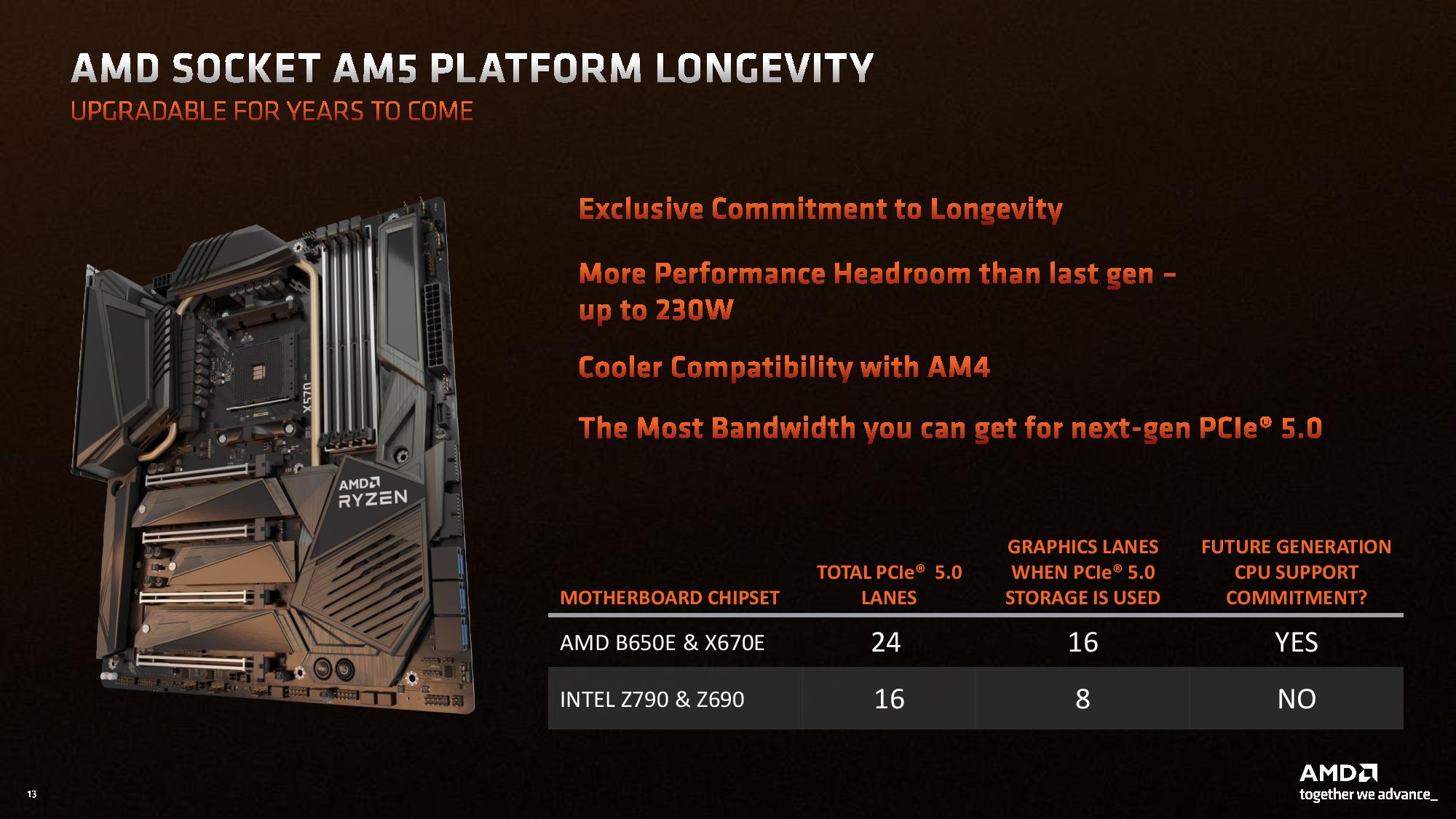
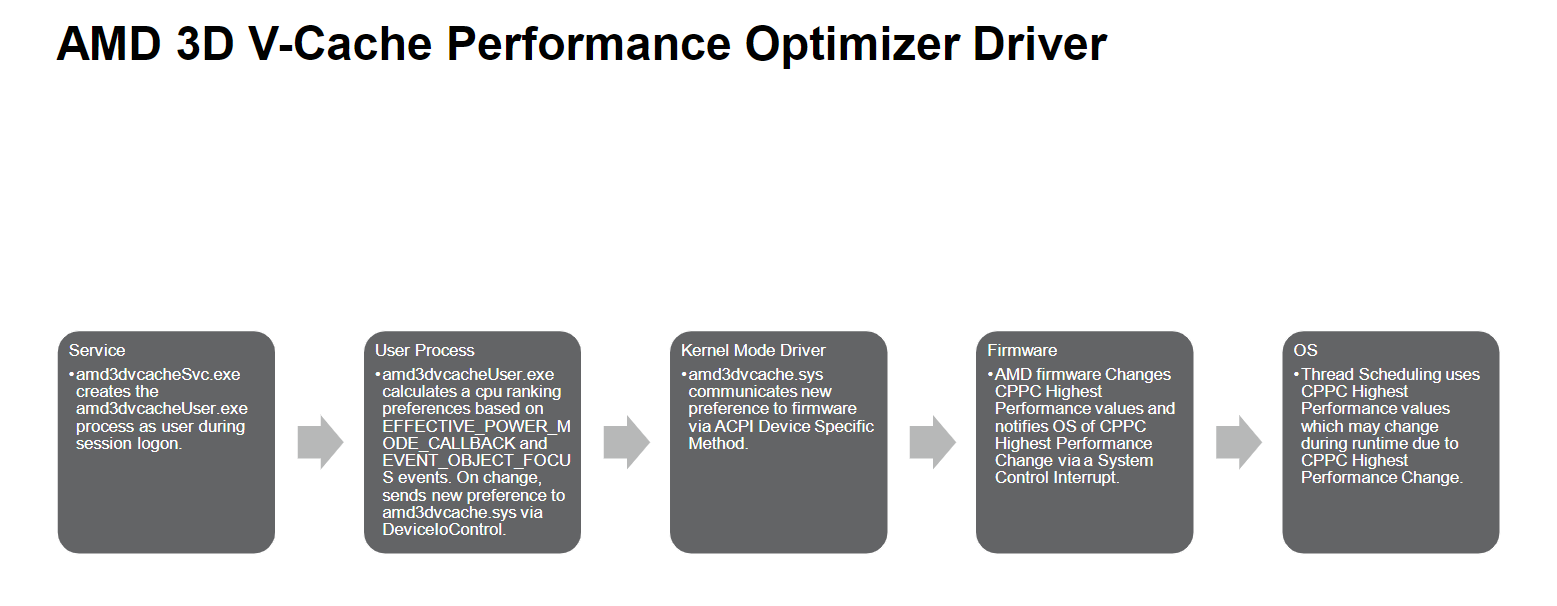
You can read the deep-dive details on AMD's thread-targeting implementation here, but the key takeaway is that the four different components work together to automatically alter the thread assignments into the cores. This technique assures the OS thread scheduler can target the correct cores based on current usage — the 3D V-Cache enabled chiplet for cache latency-sensitive tasks like gaming, or the standard chiplet for workloads that respond best to higher frequencies. You can also override the automatic switching between core-ranking modes to customize the settings, but we found that the automatic mechanisms work well.
The chipset drivers also include a component that improves performance by parking the chiplet without extra cache when Game Mode or Mixed Reality Mode is active. In effect, this shuts down the ‘standard’ CCD, thus constraining latency-sensitive workloads (like games) to the 3D V-Cache chiplet. This improves the cache hit rate and reduces high-latency communication between the two CCDs, resulting in faster performance for workloads that don’t need access to (or benefit from) all the cores.
Naturally, both groups of cores are used if the workload is parallelized enough. The thread targeting and core parking only kick in for dual-CCD Zen 4 X3D processors, so they won’t impact performance with regular chips.
Game Mode is designed to reduce the impact on gaming from background tasks, but it is best on lower-end systems. It does have a history of sometimes unnecessarily throttling background tasks on higher-end systems that don’t need as much resource preservation, which could be problematic with video streaming or other apps that run in the background. We conducted our own cursory tests and didn’t encounter any issues, but we're testing the impact of background apps further.
Now let's move on to the gaming and productivity benchmarks on the following pages.
- MORE: Best CPU for gaming
- MORE: CPU Benchmark Hierarchy
- MORE: Intel vs AMD
- MORE: How to Overclock a CPU
Current page: Not All That Glitters
Next Page AMD Ryzen 9 7900X3D: Power Consumption, Overclocking, Efficiency, Test Setup
Paul Alcorn is the Editor-in-Chief for Tom's Hardware US. He also writes news and reviews on CPUs, storage, and enterprise hardware.
-
Brian D Smith -No support for DDR4 memoryReply
LOL...that's like saying a horse cannot use an elephant's saddle. Seriously, why even say that as a negative? Oh...it's Paul. -
Giroro I question the point of a non-flagship gaming CPU when nobody is making a non-flagship gaming GPU.Reply -
logainofhades ReplyGiroro said:I question the point of a non-flagship gaming CPU when nobody is making a non-flagship gaming GPU.
The 7900xt, 4070ti, and 4080 are not flagship models. That would be the 7900xtx and the 4090. -
Metteec Brian D Smith: I get your point, but the Intel i9-13900K (the competitor to the Ryzen 9 7900X3D) supports both DDR4 and DD5. Therefore, Paul's feedback on this particular issue is warranted. AMD's design decision to switch exclusively to DDR5 is a detractor to many buyers, including myself, who would have upgraded their CPUs but can't because they would have to invest in DDR5. Conversely, Intel has eased the transition its 12th generation processor by offering compatible motherboards with either DDR4 or DDR5.Reply
I would guess that Intel's 14th generation will ditch DDR4 for good, but as of now, DDR4 compatibility is one thing that the i9-13900K has going for it over the Ryzen 9 7900X3D.
Disclosure: I hold positions in both Intel and AMD stock and use predominantly AMD products. -
2Be_or_Not2Be I wonder how the upcoming single-CCD 7800X3D will perform. I like that it's a single-CCD CPU vs the dual-CCD in the 7950/7900X3D. If it can boost to 5.6GHz, despite the official boost rating only showing 5.0GHz, then that could potentially be the best of both worlds (gaming & application, when app not limited by # of cores).Reply -
2Be_or_Not2Be ReplyMetteec said:Disclosure: I hold positions in both Intel and AMD stock and use predominantly AMD products.
Disclosure: I am currently losing money with positions in both Intel and AMD stock and use predominantly AMD products. :) -
Maebius My crystal ball foresees that after a while (a few months) , the 7900X3D will be very very closely (street)priced to the 7800X3D.Reply -
jeremyj_83 Reply
13th Gen supports DDR4 because it is socket compatible with 12th Gen. Making 13th Gen DDR5 only would have meant that Z690 (and other 12th Gen chipsets) only supported 1 CPU version. As of late Intel has made it such that chipsets support 2 generations of CPUs. When 12th Gen came out, it made sense for there to be DDR4 support as DDR5 was at a huge price premium. Fast forward to now and the price premium over DDR4 is much lower, still not 1:1 but..., so supporting 2 memory types is only for socket compatibility for Intel's standard 2 generations. Had Intel gone DDR5 only on 13th Gen we probably would have seen DDR5 prices drop much faster than they already are.Metteec said:Brian D Smith: I get your point, but the Intel i9-13900K (the competitor to the Ryzen 9 7900X3D) supports both DDR4 and DD5. Therefore, Paul's feedback on this particular issue is warranted. AMD's design decision to switch exclusively to DDR5 is a detractor to many buyers, including myself, who would have upgraded their CPUs but can't because they would have to invest in DDR5. Conversely, Intel has eased the transition its 12th generation processor by offering compatible motherboards with either DDR4 or DDR5.
I would guess that Intel's 14th generation will ditch DDR4 for good, but as of now, DDR4 compatibility is one thing that the i9-13900K has going for it over the Ryzen 9 7900X3D.
Disclosure: I hold positions in both Intel and AMD stock and use predominantly AMD products. -
Roland Of Gilead Reply
Agree with you for the most part, but this idea that DDR5 is a killer for any consumers and having to go with AMD (without choice) for Zen4/AM5 doesn't add up. DDR4 support for Intel's current 13th Gen ends with Raptor. (maybe a Raptor -s not known yet). Meteor or next desktop is exclusively DDR5. Add to that, that AMD will support maybe 3/4 new CPU's on the same socket. Intel don't do that. The cost upfront, of maybe 100-150, sure does make up for not having to upgrade on Intel every two years.Metteec said:Brian D Smith: I get your point, but the Intel i9-13900K (the competitor to the Ryzen 9 7900X3D) supports both DDR4 and DD5. Therefore, Paul's feedback on this particular issue is warranted. AMD's design decision to switch exclusively to DDR5 is a detractor to many buyers, including myself, who would have upgraded their CPUs but can't because they would have to invest in DDR5.
For what it's worth, I'd rather have a socket that lasts 4-5 years, and allow for simple drop in upgrades, that are and can be substantive. -
DavidLejdar I am avoiding the 7900X3D. Some games like to use up to 8 cores (when they are available), and the 6+6 setup means that some workload gets directed to 2 additional cores on the second CCD. This doesn't mean a stutter-fest. But what's the point (for gaming as such), when the 7800X3D may actually deliver better gaming performance, having 8 cores with 3D V-Cache?Reply
I think it is fair to point out that the CPU goes only with DDR5. But it would also be fair to run some tests comparing gaming performance of e.g. the 13900K with DDR4 and DDR5, as the charts seem to be presenting the performance with DDR5 only, which then makes it a somewhat moot point to say: "And this one can use DDR4 as well, which is a huge plus.", without then elaborating whether a DDR4 rig does deliver the same performance as a cheaper CPU with DDR5 perhaps may, etc.Metteec said:I would guess that Intel's 14th generation will ditch DDR4 for good, but as of now, DDR4 compatibility is one thing that the i9-13900K has going for it over the Ryzen 9 7900X3D.
